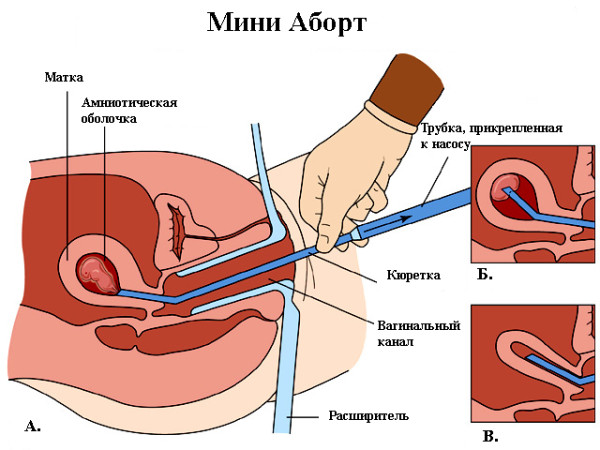Vacuum aspiration
For most women, the words "vacuum aspiration" are associated with unwanted pregnancy. Indeed, this technique is often used to have an abortion. But there are other reasons for its implementation.
Content
How vacuum aspiration is done
Vacuum aspiration is essentially a small operation, during which the contents of the inner part are removed by suction. uterus... In this case, the organ is minimally injured. Only the endometrium of the uterus moves away, and the walls of the organ and its neck remain unaffected.
Before performing vacuum aspiration, a woman needs to undergo tests, the purpose of which is to establish the gestational age of an abortion and the presence of inflammatory processes. The procedure itself is performed on an outpatient basis and takes only 10 minutes.
To begin with, the external genital organs are treated with an antiseptic, then anesthesia is done. The procedure is carried out either under general anesthesia or using local anesthesia. In the latter case, the woman feels tolerable pain in the lower abdomen.
A pump tip is inserted into the uterus. In this case, nulliparous women pre-expand the neck with a special tool. With the help of a pump, the contents of the uterus are exfoliated and removed. Then the active contraction of the uterus begins, which stops after the tip is pulled out.
Vacuum aspiration - indications
This procedure is used often enough to terminate a pregnancy. But at the same time, the gestational age should be small - less than 5 weeks, or rather, up to 21 days of the absence of the next menstruation. In addition to abortion, there are other indications for vacuum aspiration:
- Interruption for pathologies of pregnancy development.
- To improve the contraction of the uterus in the postpartum period. Vacuum aspiration removes the remnants of the placenta and blood clots that prevent the organ from fully contracting.
- In case of spontaneous miscarriage, to remove residues or in case of a frozen pregnancy.
- With inflammatory processes in the organ cavity.
- To obtain samples of endometrial pathologies for the purpose of subsequent histological examination.
- With uterine bleeding or accumulation of blood or other fluid in the uterus.
There are a number of contraindications for vacuum aspiration. These include:
- The pregnancy is too long.
- Exacerbation of chronic inflammation or acute inflammation.
- Infectious process.
- Abnormal development of the uterus.
- Neoplasms in the uterus, deforming it. For example, if there is fibroids.
- Other serious illnesses of a woman.
- Less than six months have passed since the previous termination of pregnancy.
Recovery after vacuum aspiration
Since the operation lasts only a few minutes and does not cause much harm to the organ, a woman can go home 1 hour after it has been carried out. For about two weeks after vacuum suction, a woman may experience slight bleeding like menstruation. All this time it is necessary to use sanitary pads. Do not use hygienic tampons for this purpose for the first month after surgery.
Often after the operation, a woman feels tired and dizzy. This is a normal reaction of the body. It is best to stay at home and rest the first day after the operation. If there is a feeling of discomfort or painful sensations, then you can take a pain reliever.
In the following days, it is necessary to continue taking pain relievers. If the operation was performed under general anesthesia, then avoid any activities that require high concentration of attention for another 38 hours.
2 weeks after vacuum aspiration, the woman needs to return to the antenatal clinic and conduct a control ultrasound. If its results show that the uterus is not completely cleaned out, then a second procedure is carried out or the organ cavity is cleaned by manual scraping.
Sexual life is prohibited until the discharge has completely ceased, and then it is imperative to be protected with contraceptive drugs. This is necessary to prevent a new pregnancy and to reduce the risk of disease. If you have signs of infection, such as nausea, a strong odor from discharge, hard-to-bear pain in the lower abdomen, bloating, heavy bleeding with the presence of clots, then see your doctor right away.
Pregnancy after abortion
Most women mistakenly believe that after an abortion, they will not become pregnant at least until the first menstruation. It's not like that at all. With a successful uncomplicated abortion, a woman is capable of pregnancy in 2 or 3 weeks. So if you don't burden yourself contraception, then menstruation can not wait.
The female body perceives the termination of pregnancy as the beginning of the next cycle. In this regard, a new egg cell immediately begins to ripen. This means that ovulation will occur a couple of weeks after the abortion, and a new pregnancy may occur at about the same time. But since the endometrium does not have time to fully recover in such a short time, the development of pregnancy in this case is impossible and a miscarriage occurs.
Pregnancy should not be planned for at least six months. During this time, it is necessary to do everything possible to restore health, use contraception during sex. In some cases, the recovery period can last for a year.






